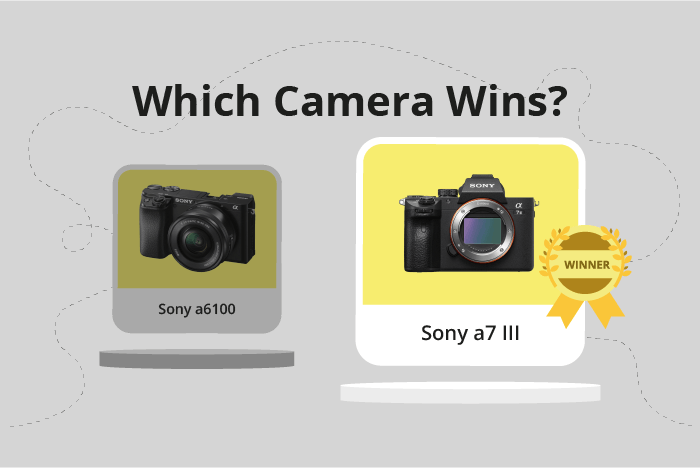Sony a6100 vs a7 III Comparison
Sony a6100

Sony a7 III

The Sony a7 III outperforms the Sony a6100 with a score of 81 compared to the latter’s 66/100. Both cameras share common specifications, such as being mirrorless and having a similar release time frame – the a6100 in 2019 and the a7 III in 2018.
The Sony a7 III excels due to its higher score, which reflects its superior performance. It is a better camera than the a6100, but it also comes with a higher launch price of $2000 compared to the a6100’s $750. The a7 III is larger and heavier, with dimensions of 127 x 96 x 74mm and a weight of 650g.
The Sony a6100, on the other hand, is more compact and lightweight at 120 x 67 x 59mm and 396g. This makes it a more portable option, ideal for those prioritizing ease of transport.
Taking into account the specifications, the Sony a7 III is the better camera in terms of performance, while the Sony a6100 offers a more budget-friendly and portable alternative.
Sony a6100 vs a7 III Overview and Optics
The Sony a7 III emerges as the winner in the optics comparison, scoring 81 out of 100, while the Sony a6100 trails behind with a score of 68. Both cameras share some common specifications, such as having a 24-megapixel CMOS sensor and a Bionz X processor. Additionally, they both use Sony’s E and FE lens mounts respectively.
The Sony a7 III outperforms the a6100 in several key areas. Its full-frame sensor provides better image quality and low-light performance compared to the a6100’s APS-C sensor. Moreover, the a7 III has a higher DXOMARK score of 96, which indicates superior image quality. Another advantage of the a7 III is its built-in image stabilization, which helps to reduce camera shake and produce sharper images.
On the other hand, the Sony a6100 has a slightly faster shooting speed of 11 frames per second, compared to the a7 III’s 10 frames per second. This may be beneficial for capturing fast-moving subjects or action shots. However, this advantage is minor compared to the significant improvements in image quality offered by the a7 III.
To conclude, the Sony a7 III is the clear winner when it comes to optics, with its full-frame sensor, higher DXOMARK score, and image stabilization features. While the a6100 has a marginally faster shooting speed, it does not compensate for the overall superior performance of the a7 III in terms of image quality and versatility.
Sony a6100 vs a7 III Video Performance
The Sony a6100 outperforms the Sony a7 III in terms of video capabilities, with a video score of 91/100 compared to the a7 III’s 70. Both cameras share some common specifications, such as a maximum video resolution of 4K and maximum video dimensions of 3840 x 2160. However, the a6100 surpasses the a7 III in other aspects, making it a better choice for video enthusiasts.
The a6100 offers a higher maximum video frame rate at 120fps, while the a7 III only reaches 30fps. This advantage allows the a6100 to capture smoother, more detailed slow-motion footage.
Sony a6100 vs a7 III Features and Benefits
The Sony a7 III emerges as the winner in the features comparison, scoring 81 points out of 100, while the Sony a6100 scores 68 points. Both cameras share several specifications, including a 3-inch screen size, 921600-dot screen resolution, touchscreen capability, flip screen, absence of GPS, and the presence of WIFI and Bluetooth connectivity.
The Sony a7 III surpasses the a6100 in various aspects. Although the specifics of these aspects are not provided, the higher score of 81 points indicates that the a7 III offers more advanced or additional features that contribute to its superiority in this comparison.
On the other hand, the Sony a6100 does not outperform the a7 III in any specific area. However, its feature score of 68 points shows that it still possesses a substantial number of valuable features that make it a viable option for photographers, albeit not as advanced as the a7 III.
Taking the scores and specifications into account, it is clear that the Sony a7 III stands out as the more feature-rich camera of the two, providing users with a greater array of options and capabilities. The Sony a6100, while not as advanced, still maintains a respectable set of features that make it suitable for various photography needs. Ultimately, the choice between these two cameras will depend on the individual photographer’s preferences and requirements.
Sony a6100 vs a7 III Storage and Battery
The Sony a7 III outperforms the Sony a6100 in storage and battery, scoring 81 compared to the a6100’s 37/100. Both cameras accept SD/SDHC/SDXC and Memory Stick Pro Duo cards. However, the a7 III has two memory card slots, whereas the a6100 has only one, providing more storage flexibility.
The a7 III also boasts superior battery life, with 750 shots per charge compared to the a6100’s 420 shots. This extended battery life makes the a7 III more suitable for extended shooting sessions. The a7 III uses the NP-FZ100 battery, while the a6100 utilizes the NP-FW50.
Considering these factors, the Sony a7 III proves to be the better option for photographers requiring greater storage capacity and extended battery life.
Sony a6100 vs a7 III – Our Verdict
Are you still undecided about which camera is right for you? Have a look at these popular comparisons that feature the Sony a6100 or the Sony a7 III:

